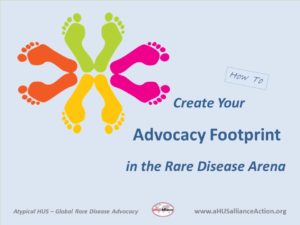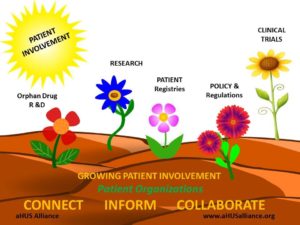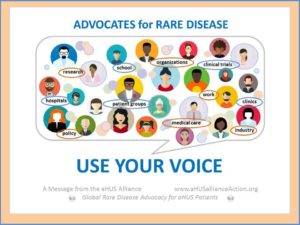
What does the term ‘rare disease advocacy’ mean to you? Patients and caregivers speaking up on social media or at various meetings, addressing needs for a particular rare disease community? People and organizations participating in broad discussions about healthcare, insurance, or governmental policies which affect rare disease patients and their care? Stakeholders creating campaigns or events to raise awareness, funds, or visibility for specific rare disease issues? Patient engagement and views shared with clinicians, academics, researchers, communication firms, and pharmaceutical companies to provide authentic insights about patient experiences? Rare disease advocacy can encompass all of these, and more. Just as what individuals say and do on a personal or professional level will create their profile for friends and their persona for employers or the general public, rare disease advocates create an “advocacy footprint” by what they post or develop, and with whom they collaborate and interact.
Just as no one rare disease patient is exactly like others sharing the same diagnosis, it’s only natural that interest areas and actions will also vary widely among rare disease advocates. If the old adage is true about how people spend their time indicates what they value, then what rare disease advocates collaborate on, post, and create should showcase their interests, abilities, and concerns. Rare diseases affect people across geographic borders, cultures, and languages so it’s not surprising that many in the rare disease arena see the value of international collaborations to add synergy and meaning to their advocacy efforts. If you’re interested in developing skills and background as a rare disease advocate, or seek to partner with rare disease advocates for projects and initiatives, here are some aspects to consider.
Raise Your Voice: But what do you have to Say?
It’s not enough to be loud. Loud voices may gain more visibility, but what happens next when all eyes are on you? What’s the value of your rare disease advocacy content that others are reading, hearing, viewing, or considering? How do your issues have meaning for other stakeholders? What original insights, graphics, viewpoints, events, or articles do you have on offer- and how they add to the conversation? Speak to almost any rare disease patient, family member, or caregiver and it’s very likely that you’ll hear an amazing rare disease journey filled with a gamut of emotion and experience that might range from desperation to inspiration, from the hope-filled to the hopeless. As with every facet of life, not every story has a happy ending and many rare disease journeys are along winding, arduous paths that stretch on for many bump-filled years.
Sharing your patient experiences is important to help others better understand a more complete, realistic view of what patients and their loved ones undergo over time. Delayed diagnosis is common for rare disease patients, as are a myriad of issues such as: physicians unfamiliar with a rare disease’s treatment and progression, access to or cost of drugs and treatments, lack of resources for the newly diagnosed, difficulty in navigating rare disease clinical and insurance situations (since most are created to deal with more common health concerns), the impact on all areas of patient life to include work or school, managing a chronic illness, and many more. Telling your story can be a powerful first step to launch forward your footprint as a rare disease advocate, creating pathways that can yield partnerships and opportunities for meaningful contributions that have broad and varied benefits .
Decide how your experiences can add insight & deepen discussions.
Every patient and their family has a unique story to tell about their rare disease journey – but reaching out to share it has the greatest impact when there is a clear focus. What’s yours? Here are some common themes of aHUS patient experiences, which have appeared in various social media posts, for sample ideas to focus your story:
delayed diagnosis
mental health (anxiety, depression)
economic stress
family caregiver issues
pregnancy/family planning
invisible illness, lack of understanding
relationship/social issues
balancing work/life/school/home
access to treatment/care
impact on lifestyle
multiple diagnoses
ways to cope, support given/received
There are unlimited ways in which your story can help provide new viewpoints for others not familiar with the impact a rare disease has not only on the patient but on their family and every component of their lives. Have you been interviewed by a local news outlet, participated in a Rare Disease Day event, organized/joined in a social media campaign, or participated in regional or national campaigns for rare disease policy issues? Share it! There are many places online to share your patient experiences as well.
Many nations have large organizations serving all rare diseases, such as: CORD (Canada), NORD (USA), and EURORDIS (the European Union, EU). There are multi-national rare disease groups such as Global Genes, and social sites like the Mighty which include patient stories. Chronic illness and kidney disease organizations often have efforts or platforms which include patient stories, as do some research centers. If you’ve been diagnosed with a rare disease like aHUS, check to see if there’s been an effort to unite patients around the world into a disease-specific global network such as the aHUS Alliance. (See the end of this article for action suggestions.)
Needs-based Advocacy
Struggling with any serious medical diagnosis is difficult, but problems in finding educational materials and patient (or caregiver) resources is exponentially more challenging for the rare disease community. At some point a rare disease patient or their caregiver will not be successful in finding a resource that would be useful in daily life. It’s at this point that some patients or their loved ones become creators of resources, fashioned out of pure need – to coin a phrase ‘needs-based advocacy’. A simple concept, important to recognize but often ignored, should be a fundamental principle for rare disease advocates: If you need it but can’t find it, build it then share it.
No communications agency or marketing company is on the front lines to fully appreciate the daily challenges of living with a rare disease. Professionals who develop educational materials for use within the rare disease arena would be well advised to review existing materials and to contact that individual or organization with these questions, “Who made this resource, and what’s the background regarding the need to create it?”. The answers can be quite humble, but are always informative. Within the aHUS community and in the case of the LabTracker, one mother developed a grid to tuck into her purse to track trends in lab values and also created a tool to track clinical symptoms as an aid to focus discussions with her child’s medical team. Given the difficulty with differentiating atypical HUS from other thrombotic microangiopathies with similar symptoms, rare disease advocates volunteering with the aHUS Alliance from the UK, USA, and Canada partnered in 2017 with physicians in Boston to initiate and implement a ‘MedEd’ event, the Thrombotic Microangiopathy Symposium: Through the Lens of aHUS, which integrated a global patient voice with clinical presentations. Collaboration and connectivity are essential to move meaningful information and assets beyond living rooms and conference room walls. Exploring those avenues can help avoid echo chambers which can hinder outreach and visibility, and do little to gain momentum for initiatives or to expand possibilities for growth.
Collaboration among People, Groups, and Nations
You are not alone. Given that, why advocate in isolation instead of acting collaboratively to include individuals and organizations that share similar interests? Rare disease advocates are in a unique position. There are so few individuals affected by a particular rare disease that avenues for collaboration are more focused, and every patient voice counts. Barriers to patient engagement may include lack of funding to attend meetings or conferences, language or translation issues among international groups, lack of open access to full text articles in medical journals, or limits imposed by the rare disease or condition itself such as unpredictable health crisis for adult patients who advocate for themselves.
Surprisingly, few stakeholders know much about the circumstances in others’ worlds which is something to explore at early stages in joint initiatives. At times marketing companies, communications firms, and others may not be aware of key resources and initiatives which could better guide their outreach and engagement efforts. This presents a perfect opportunity for rare disease advocates, who are well positioned to provide background and to suggest innovative approaches that highlight efficient and productive approaches to explore. Patient engagement with researchers, clinical trial leads, and industry should occur early and at all stages. In the case of the atypical HUS community, the aHUS Alliance’s 2016 global poll provided a pool of information to designed to provide data for national aHUS advocacy groups to present during meetings with their governmental healthcare agencies and medical regulatory boards but also provided stakeholders information about patient engagement and recruitment. As a result, those poll results created whitepapers on topics such as drug access and led to an innovative, collaborative partnership with an industry supported aHUS Global Patient Registry (Click to view: Orphanet article.)
When creating your footprint as a rare disease advocate, highlight interest areas and illustrate your views in the original content you post. Build your advocacy footprint by participation in projects and collaborative efforts. Reach out to others whose ideas and efforts you find to be interesting and informative, and seek out opportunities to join in efforts begun by others. One cautionary note for rare disease advocates: understand the intent of those seeking your time, opinions, and efforts as there are rare circumstances when contacts seek to mine information or solicit details regarding contacts to develop for-profit reports sold to third parties.
Building Pathways that Optimize & Unite
One thing is constant for most rare disease advocates, and that is a lifelong need to keep informed and active as a key member of their medical team. When companies have a new therapeutic drug in their pipelines, or a medical advancement affecting patient care or prognosis, it’s often the rare disease advocate who is among the first to know. No company or senior staff member in academia or industry has so much at stake as those people who have a loved one with, or who themselves are personally affected by, a rare disease. Spotlighting unmet needs, rare disease advocates can provide insight into structures or efforts that are currently fragmented but could be reworked to better optimize opportunities or information flow.
As recipients of medical care, patients are participants in research and clinical trials. Adult patients and pediatric caregivers are decision makers in treatment options, making them excellent partners for stakeholders in a variety of fields and endeavors. Patient engagement is sometimes more a buzzword than a reality. Yet as companies restructure and staff people are hired or accept new positions elsewhere, it’s the patients and their families that remain a true constant. Sadly it’s not uncommon for pathways of patient involvement and communication with advocates to crumble with staff turnover in industry positions. At that point rare disease advocates are faced with rebuilding an interface, and it’s not clear whether industry actually realizes that that advocates’ volunteer time is often repeatedly requested to provide background and some sense of continuity for people employed new staff position.
Creating Your Footprint as a Rare Disease Advocate
What moves you, and concerns you, as a rare disease advocate? Although small numbers of people are by affected by any one of the estimated 7000 rare diseases, chances are that there are broad issues that affect many people living with a rare disease. Certain universal issues affect those challenged by a chronic or serious disease, such as: the economic burden of chronic illness, impact on work/school or family schedules
Consider creating a distinct and unique advocacy platform that highlights what is meaningful to you, and focuses on actions you personally feel are important. Many clinicians, pharma, and researchers either monitor Twitter or actively have a Twitter account to engage with other professionals. If your passion is linked to areas such as clinical trials, new therapeutic drugs, medical advancements, and research news it is likely that you’ll find an active community posting on such topics on Twitter. Patient voices are distinct and unique, so what focus will you choose? Although almost all rare disease advocates are unpaid volunteers, strive to create a professional and responsible image and avoid the temptation to intermix sports, politics, or personal content within your advocacy footprint. If a potential partner Googles your name with key words related to your specific rare disease advocacy area
Rare Disease Advocacy – Get Started Now!
Everyone’s situation is different, and every patient and caregiver experience has value. Realize that rare disease advocates are self-made, by virtue of their actions and ideas. Rare disease advocates grow- despite challenges. Here are some suggestions to help you develop your rare disease advocacy footprint.
- Create an advocacy-specific Twitter account. If your interest area is research, clinical, rare disease issues, drug research and development, or disease-specific content, Twitter hosts a robust array of groups and individuals which actively post on such topics. Click links to view the Twitter accounts of the aHUS Alliance, @aHUSallianceAct and aHUS Awareness Day @aHUS24Sept (held annually on 24 September).
- Create a Facebook group dedicated to a topic, issue, or need – if one does not already exist. Since rare disease groups have such low patient numbers, you’ll find global connectivity a great resource since it’s unlikely that there will be a local support group your region. For example the international aHUS community of patients, caregivers, families, and others offers a public Facebook page to share information and support. Click the link for the aHUS Alliance Facebook
- Ask to be a Contributing Author. Many rare diseases do not have a disease-specific organization, but you can still be a valuable voice. National rare disease organizations, organ-specific or genetic groups, and others may welcome new content. Look at websites and social media for a match of content/intent and connect via email, and ask if they accept articles by contributors. Provide a short description of your rare disease advocacy interests, and include a very brief general outline of the article’s key points. Share links to your advocacy footprint, which might include: participation in global events such as Rare Disease Day, your advocacy-specific social media accounts, local or regional advocacy participation, assets you have developed, or projects or events which you have initiated.
- If you are fluent in another language, offer to translate an existing rare disease resource, or text within a great graphic, into your native language.
- Make a YouTube Video. Share your rare disease experiences, with a focus on how your video might inspire or inform. Make a video that offer an overview of an issue, concern, or need. Highlight your initiatives, helpful resources, or awareness event. Share this YouTube link with other rare disease advocates, groups, and organizations along with information about yourself and an invitation for them to contact you.
Note: The aHUS Alliance is an at-will group of people and groups in more that 30 nations, dedicated to promoting better outcomes for the rare disease atypical HUS. This volunteer group of aHUS patients and their families partner with research teams, academics and industry.
E: info@aHUSallianceAction.org




